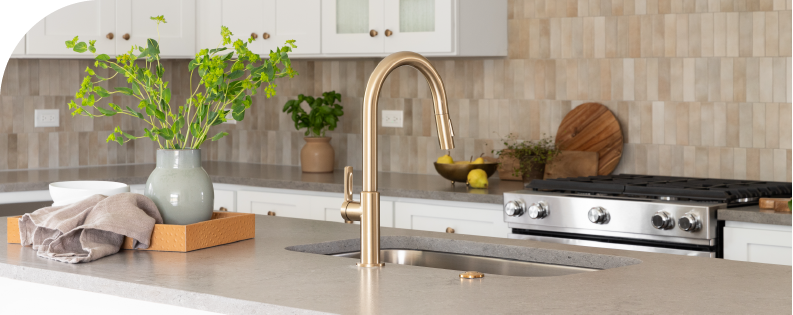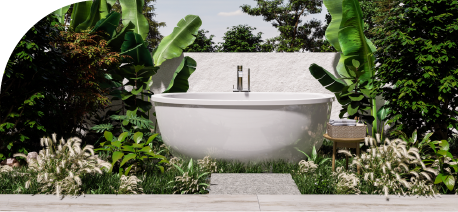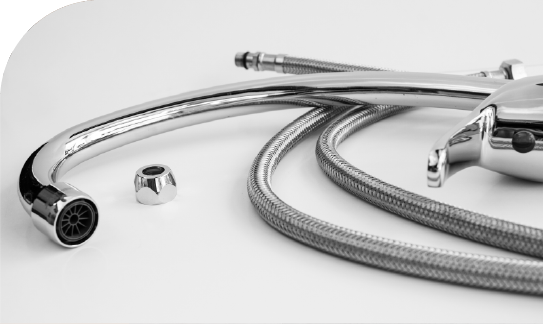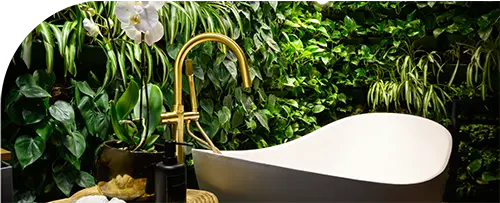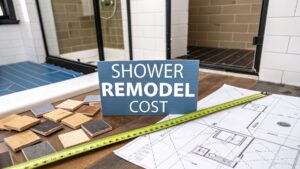Let’s get straight to the point: how much does it cost to remodel a bathroom shower? While the national average hovers around $8,200, the real answer depends entirely on your vision. You could be looking at anywhere from $1,000 to $15,000. The final number comes down to two big things: the materials you fall in love with and how complex the job is.
Your Shower Remodel Cost at a Glance
When you start digging into the numbers, you’ll see a huge spectrum of possibilities. A simple refresh is one thing; a total luxury transformation is another beast entirely. According to the National Kitchen & Bath Association, a shower remodel is a significant part of any bathroom renovation. Nationally, putting in a new shower averages out to about $8,200.
But don’t let that big number scare you. You can find more budget-friendly routes, like using a prefabricated shower kit, which can keep your costs as low as $500 to $1,000. Most projects, however, will land somewhere in the middle, typically between $800 and $5,000. If you’re dreaming of a high-end, walk-in shower with all the bells and whistles, be prepared for the price to climb to $14,300 or even higher.
“A shower remodel is one of the most impactful upgrades you can make to a bathroom, often accounting for 5% to 25% of the total renovation budget. Understanding the cost tiers from the start is crucial for a successful project.”
Estimated Shower Remodel Costs by Project Tier
To help you get a clearer picture of what your budget can get you, we’ve broken down the costs into three common tiers. Think of this as a road map to match your dream shower with a realistic price tag.
| Remodel Tier | Estimated Cost Range | Common Features |
|---|---|---|
| Basic Refresh | $1,000 – $4,000 | Prefabricated stall, new showerhead, basic acrylic/fiberglass surround. |
| Mid-Range | $4,000 – $10,000 | Ceramic or porcelain tile, semi-frameless glass door, upgraded fixtures. |
| Luxury Overhaul | $10,000 – $15,000+ | Natural stone, custom tilework, frameless glass, bench, multiple shower heads. |
This table gives you a solid starting point for planning. It’s all about balancing what you want with what you’re ready to invest.
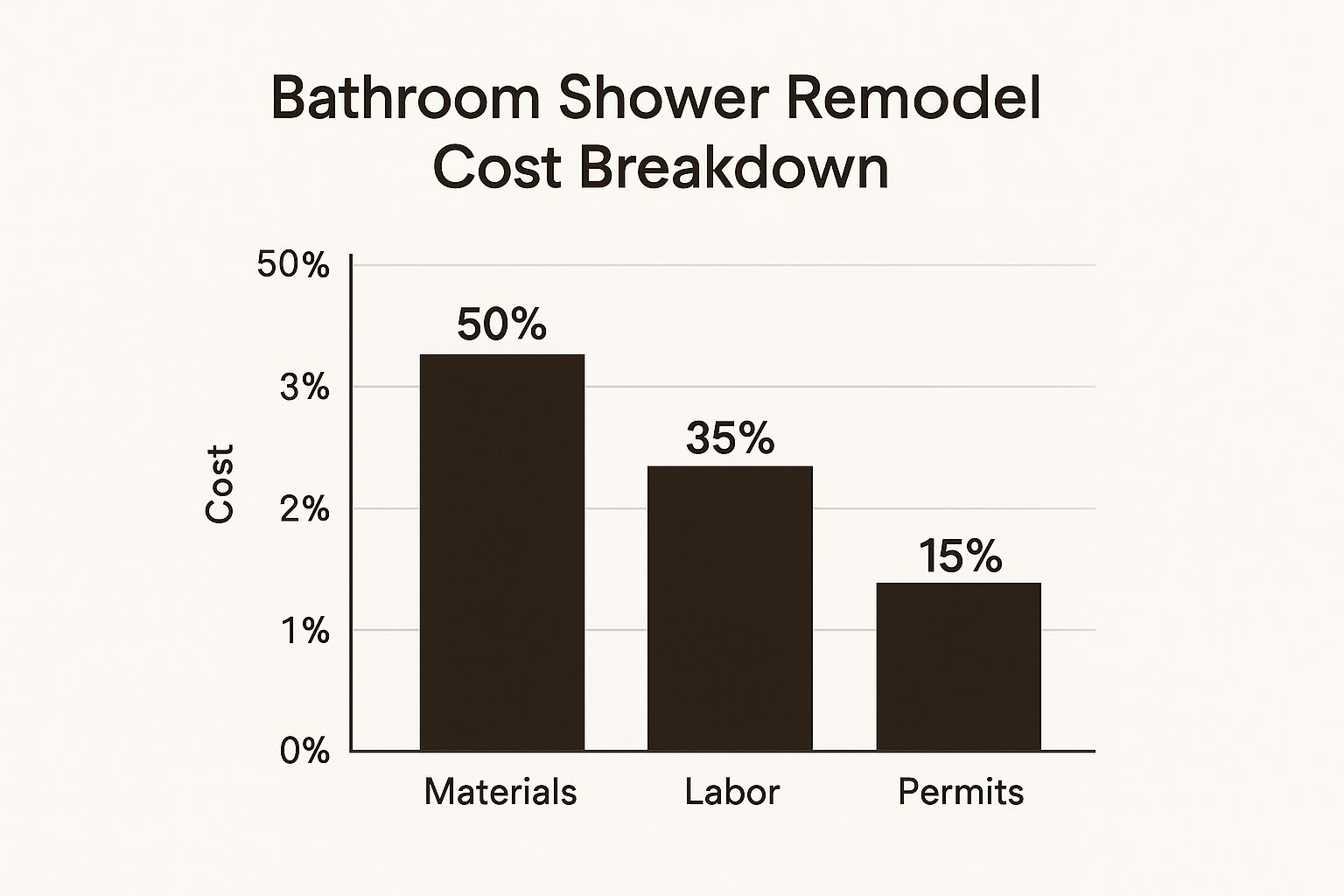
As you can see, the two heavy hitters in any shower remodel are always materials and labor. They’re going to command the lion’s share of your budget. If you want to dive even deeper into every last detail, check out our comprehensive guide on how much to remodel a shower.
Decoding Your Remodel Budget: Materials vs. Labor
When you start digging into the question, “how much does it cost to remodel a bathroom shower?“, you quickly find that it all boils down to two major buckets: materials and labor. Think of them as two sides of the same coin. Understanding how they work together is the first real step in planning a renovation that won’t give you sticker shock.
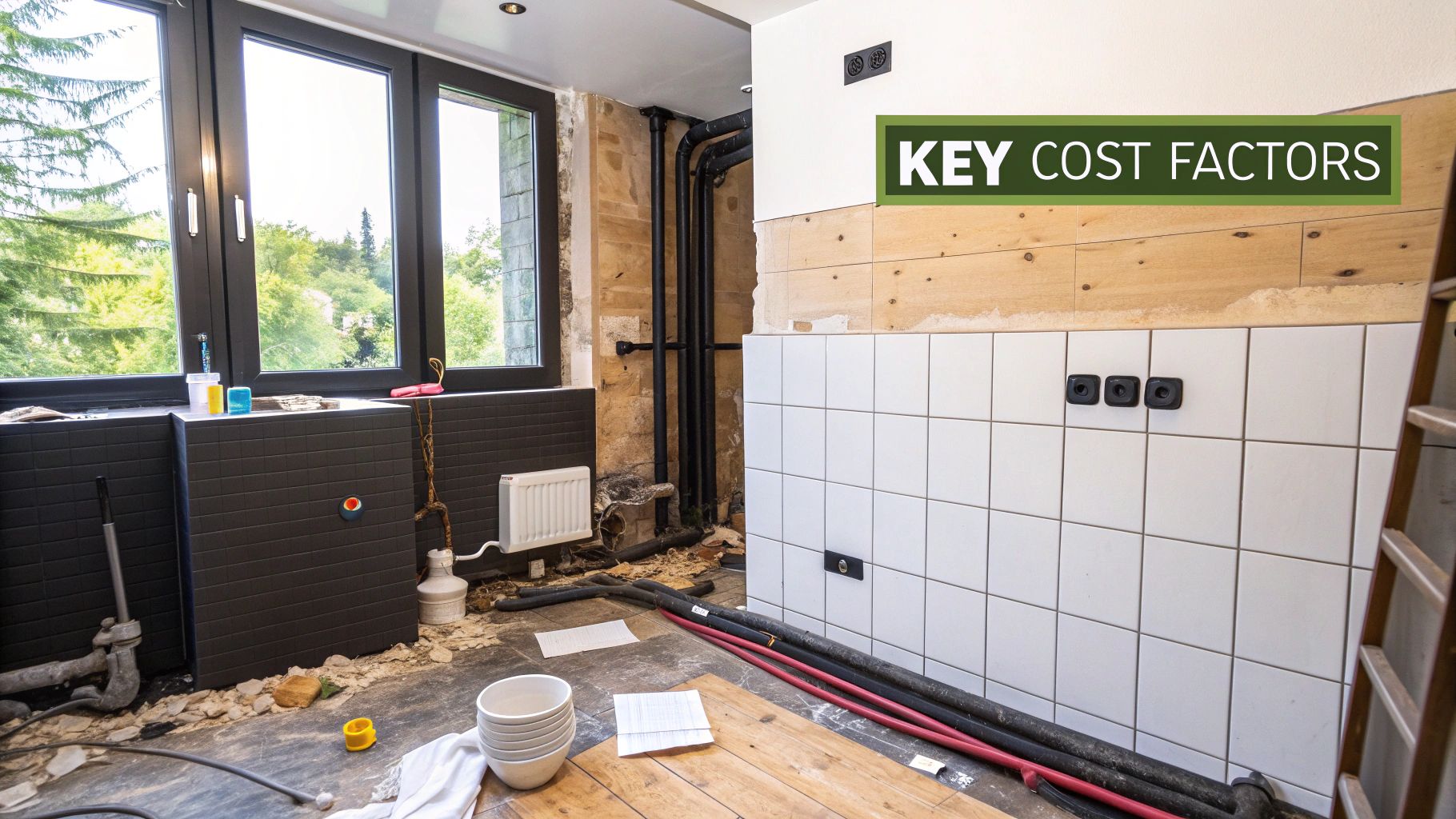
It’s natural to get excited about the things you can see and touch—those gorgeous tiles or that sleek, frameless glass door. But here’s a secret from the pros: the skilled labor needed to put it all together often makes up the biggest chunk of the final bill.
The True Cost of Labor
Hiring skilled professionals is an investment in quality and, frankly, your own peace of mind. It’s tempting to try and cut corners on labor, but a pro’s expertise is what guarantees your new shower isn’t just beautiful but also watertight and built to last.
Time and again, cost analyses show that labor eats up 40% to 60% of the total project budget. Industry data points to an average shower remodel costing around $7,100 for a standard size. Here’s something that surprises many homeowners: the final price doesn’t swing wildly between small, medium, or large showers. In fact, the cost difference can be as little as $30. What really moves the needle is the quality of the materials and the complexity of the design.
So, what are you paying for? Professional contractors handle all the critical tasks that are invisible once the job is done but are absolutely essential for a durable, problem-free shower:
- Demolition: Carefully tearing out the old shower, tiles, and fixtures without causing collateral damage to your walls or plumbing.
- Plumbing: This might be a simple job of hooking up new fixtures, or it could involve the more complex work of rerouting water supply and drain lines to fit a new layout.
- Waterproofing: This is arguably the most critical step. Pros apply specialized membranes and sealants to the walls and floor, creating a barrier that prevents leaks, water damage, and mold growth down the line.
- Installation: This is the finish work—precisely placing the shower pan, meticulously setting and grouting tile, and perfectly installing glass doors and fixtures.
A beautifully tiled shower with a faulty waterproof membrane is a disaster waiting to happen. Professional labor isn’t just a service; it’s insurance against costly future repairs.
Choosing Your Materials
While labor is a huge piece of the puzzle, your material choices have an equally powerful impact on your final cost. This is where you get to put your personal stamp on the project and define the look and feel of your new shower. Opting for a high-end shower system from a quality brand like CRANACH, for instance, can instantly elevate the entire experience.
The core material decisions you’ll be making include:
- Wall Surrounds: Your options here are vast, from budget-friendly prefabricated acrylic or fiberglass panels all the way up to custom-tiled walls using ceramic, porcelain, or luxurious natural stone.
- Shower Pan (Base): You can go with a standard acrylic or fiberglass base, or you can choose a custom-tiled shower floor, which requires significantly more labor and specialized materials.
- Fixtures: This is the shower system itself—the showerhead, valve, and any extras you might want, like a handheld sprayer or invigorating body jets.
- Glass Enclosure: From a standard framed door to an elegant, minimalist frameless glass panel, the enclosure is a major aesthetic choice and a significant cost factor.
Finding the right balance between these two major expenses is the secret to a successful remodel. For a deeper dive into all the costs involved, be sure to check out our complete guide on how much does it cost to remodel a shower.
Choosing Materials For Your New Shower
The materials you choose are the very heart of your new shower. They’re what you’ll see and touch every day, and they have the biggest say in the final look, how long it lasts, and a huge chunk of how much it costs to remodel a bathroom shower. Think of it like cooking a special meal—the quality of your ingredients determines everything.
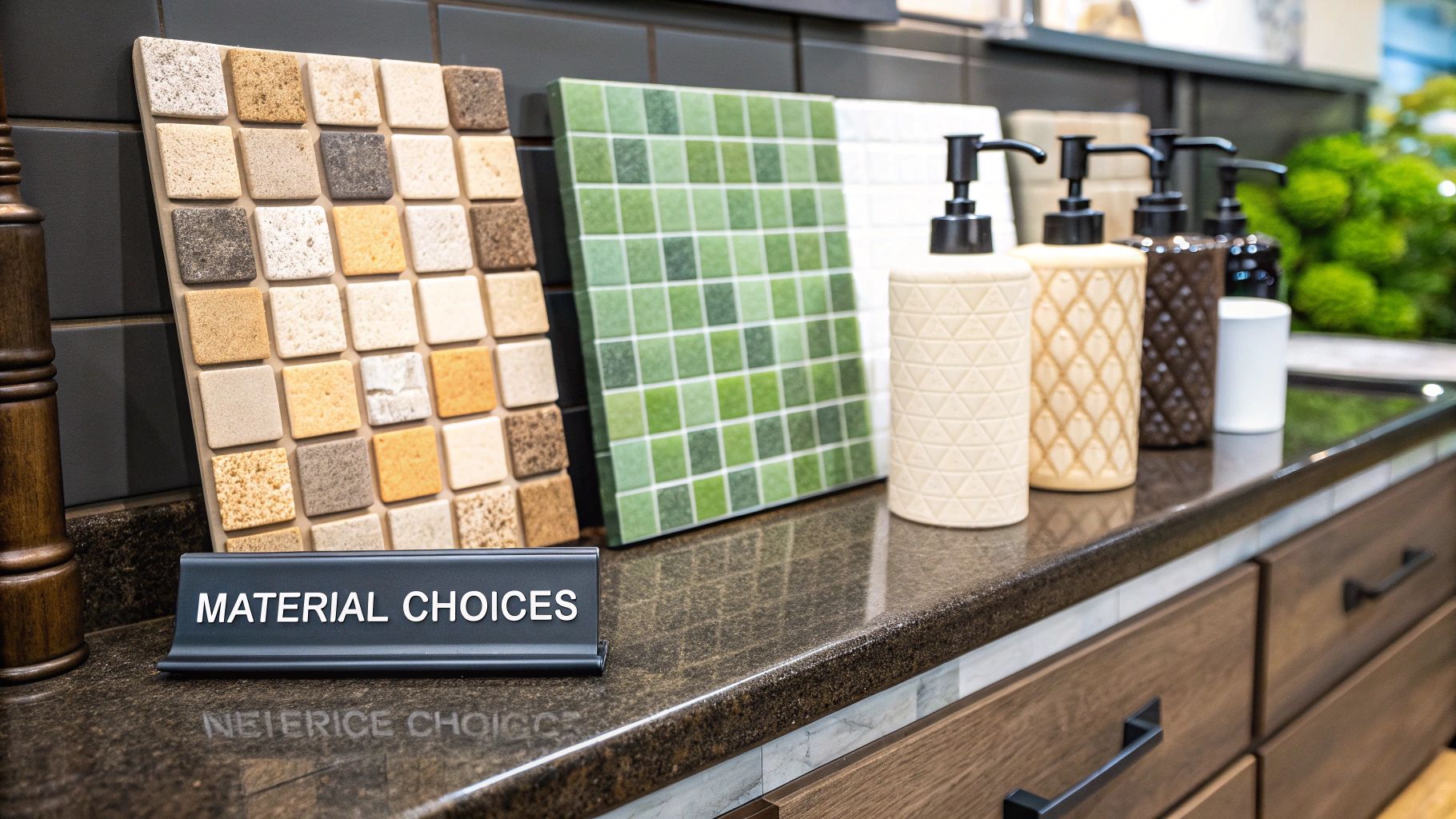
From the shower walls and floor right down to the glass door, every single choice matters. Let’s walk through the most common options so you can make these big decisions with confidence.
Shower Walls and Floors: Tile vs. Prefabricated
The surfaces of your shower are what catch the eye first, setting the entire mood for the bathroom. Your main decision here boils down to two paths: classic, custom tilework or a modern, prefabricated unit.
- Ceramic and Porcelain Tile: These are the go-to choices for a good reason. Ceramic is a budget-friendly and incredibly versatile option, while porcelain is its tougher cousin—denser and less porous, making it perfect for wet, high-traffic areas. You can expect tile costs to run anywhere from $4 to over $20 per square foot, not including installation.
- Natural Stone: If you’re dreaming of a high-end, spa-like escape, nothing beats materials like marble, slate, or travertine. They’re stunning, but they do come with a premium price tag (often $15 to $60+ per square foot) and need to be sealed regularly to keep them looking great and protected from water damage.
- Prefabricated Surrounds: Made from acrylic or fiberglass, these one-piece or multi-piece kits are a fantastic, low-maintenance alternative to tile. They are much quicker to install, which saves a bundle on labor costs, but you do trade some of that custom design flexibility.
What’s behind the tile is just as important as the tile itself. A shower built on a shaky foundation won’t last. To ensure your investment is protected from the inside out, look into quality waterproofing options like specialist boards.
Fixtures and Glass Enclosures
The hardware and glass are the jewelry of your shower—the final, defining touches. A great shower system can completely change your daily routine, turning a quick rinse into a genuinely refreshing experience.
When it comes to the enclosure, the type of glass you pick makes a huge difference in both the look and feel of the space:
- Framed Doors: This is the most budget-friendly route, with metal framing around the glass panels. It’s a classic, reliable choice.
- Semi-Frameless Doors: A nice middle-ground option that gives you a cleaner, more modern look with minimal framing.
- Frameless Doors: The top-tier choice. These doors use thick, heavy-duty tempered glass for a seamless, almost invisible look that makes your entire bathroom feel bigger and more open.
Every material and fixture you select is a piece of your final budget puzzle. The real secret to a successful remodel is finding that perfect balance between the look you want, the durability you need, and the price you can afford. That’s how you build a shower you’ll be happy with for years.
Elevate Your Space With the Right Shower System
While tile and glass get plenty of attention, the real heart of your new shower is the hardware that actually delivers the water. A great shower system does more than just get you clean—it can turn your daily routine into a spa-like escape. It’s a key part of figuring out how much it costs to remodel a bathroom shower, but think of it as an investment in your everyday well-being.
This is where you can truly personalize the shower experience. Your options range from a simple, elegant single-head faucet to much more complex setups. We’re seeing more and more homeowners opt for full-blown systems that include a luxurious rainfall head, a flexible handheld wand, and even invigorating body jets for a true hydrotherapy session.
This image shows a complete shower system from CRANACH, a top choice for people looking for high-quality, innovative fixtures. Look at how the rainfall head and handheld wand offer both indulgence and pure practicality. It’s a perfect example of how the right shower system can become the stunning centerpiece of your entire bathroom remodel.
Investing in Quality and Performance
When you’re picking out fixtures, it’s not just about looks. Performance and durability are what really matter in the long run. A premium shower system from a brand like CRANACH is engineered for superior water flow, rock-solid temperature control, and reliability that lasts for years. These systems are designed to deliver a therapeutic and healthy shower, turning a purely functional space into your own personal retreat.
Choosing a complete shower system from a single, trusted brand also guarantees that all the parts work together perfectly, both mechanically and visually.
A high-quality shower system is an investment that pays you back every single day in comfort and satisfaction. It elevates the whole project from a simple update to a genuine lifestyle improvement.
The cost for these systems can vary quite a bit:
- Basic Fixtures: A simple showerhead and valve might only set you back $150 to $400.
- Mid-Range Systems: A quality set with both a rainfall head and a handheld sprayer typically runs from $400 to $1,000.
- High-End Systems: For the full spa experience with multiple body jets and advanced controls, you could be looking at an investment of $1,000 to $3,000+.
While a premium shower system does add to the upfront cost, its impact on your daily life and the bathroom’s overall vibe is huge. To get inspired by what’s new in bathroom aesthetics, you should explore these emerging bathroom design trends for 2025. And don’t forget, other elements like stylish bathroom window treatments can also pull the whole look together. By choosing each piece carefully, you create a cohesive, luxurious space you’ll be happy with for years to come.
What to Expect at Different Budget Levels
So, how much does it cost to remodel a bathroom shower, really? The best way to get your head around the numbers is to think about it like buying a car. What you decide to spend will determine whether you drive off in a reliable daily driver or a high-performance luxury model. The same idea applies to your shower—every price point unlocks a whole new level of materials, features, and finishes.
Getting familiar with these budget tiers is the key to matching your dream shower with a realistic financial plan right from the get-go. Let’s walk through what you can actually get for your money at basic, mid-range, and luxury price points.
The Basic Refresh: $1,500 – $4,000
At this entry-level price, the goal is to make a big visual impact with a few smart, targeted upgrades. This isn’t about gutting the whole space; it’s more of a strategic refresh. You’re simply swapping out the old, tired components for something fresh and clean.
Here’s what you can generally expect with a basic refresh:
- Installing a new, standard-sized prefabricated shower stall, usually made from affordable acrylic or fiberglass.
- Replacing an old showerhead and faucet with new, but basic, fixtures.
- Retouching or re-doing the grout and caulk to give the entire area a clean, crisp feel.
This approach is perfect for a guest bathroom or for anyone who needs a functional, good-looking update without jumping into a massive project. It’s all about getting the most bang for your buck.
The Mid-Range Makeover: $5,000 – $10,000
Moving up to the mid-range is where things get exciting. This budget opens up a ton of possibilities for customization and much nicer materials. You’re no longer just replacing parts—you’re actually starting to redesign the space to fit your personal style and improve your daily routine.

A mid-range budget can comfortably cover:
- Custom Tile Work: Think classic ceramic or super-durable porcelain tiles for the walls and shower floor.
- Upgraded Enclosure: Installing a semi-frameless glass door, which instantly makes the space feel more modern and open.
- Enhanced Fixtures: Investing in a quality shower system, like those from CRANACH, that might include both a fixed rainfall showerhead and a handheld wand for extra convenience.
This is the sweet spot for most primary bathroom remodels, offering a fantastic balance between cost and high-impact, satisfying upgrades. For a deeper dive into this popular option, check out our guide on how much is a walk-in shower.
The Luxury Overhaul: $12,000+
Welcome to the personal spa experience. A luxury budget means you can go all-in on high-end materials, sophisticated features, and a completely custom design built just for you. The focus here shifts from pure function to creating an indulgent, almost therapeutic, daily ritual.
High-end remodels with luxury features like rainfall showerheads, custom tiling, and premium glass enclosures can cost from $12,000 to $25,000 or more. Industry experts consistently advise budgeting an extra 10–15% for unexpected issues. You can explore more detailed cost breakdowns from leading home improvement resources to prepare for your project. Learn more about shower remodel cost estimates at bobvila.com.
In a luxury project, you can bring in incredible features like a curbless, walk-in design for a completely seamless look, floor-to-ceiling natural stone tiles, and an advanced shower system with multiple body jets. It’s the ultimate investment in your home—and in your own daily comfort.
Frequently Asked Questions About Shower Remodels
Remodeling a shower can feel like a huge undertaking, and it’s natural for a bunch of questions to pop up. Getting clear, straightforward answers is the best way to move forward feeling confident that your project will match both your vision and your wallet. Let’s tackle some of the most common questions we hear from homeowners.
How Long Does a Shower Remodel Take?
The timeline really hinges on how deep you’re going with the changes. A simple swap, like pulling out an old unit and putting in a new prefabricated one, is often surprisingly fast. You can usually get that done in just 2 to 4 days, which is a great choice if you need a quick, functional update without tearing up your life for weeks.
On the other hand, if you’re dreaming of a custom tile shower, you’ll need to be more patient. This kind of project is far more detailed and typically takes anywhere from 1 to 3 weeks. That longer schedule isn’t just for show; it covers all the crucial steps like demolition, plumbing tweaks, meticulously setting each tile, and giving the mortar, waterproofing, and grout the proper time to cure.
Trying to rush a custom job is never a good idea. Complex patterns or moving the plumbing will add even more time, but that patience is what gets you a high-quality shower that will last for years.
Can I Save Money With a DIY Approach?
Absolutely, but you have to be smart about it. You can definitely trim the final bill by rolling up your sleeves and handling tasks like demolition, painting, or hauling away the old debris. These jobs are heavy on labor but don’t require a special license to get done.
CRITICAL WARNING: When it comes to plumbing and waterproofing, stop right there and call a professional. A tiny mistake in these areas can turn into a catastrophic nightmare of water damage, hidden mold, and structural rot. The cost to fix that kind of damage will dwarf any money you thought you were saving.
Think of hiring a licensed pro for these critical steps as an investment. It’s not just about the shower; it’s about protecting your home and your peace of mind.
What Are Common Hidden Costs to Plan For?
Even with the most detailed plan, you never truly know what’s behind the walls until they’re opened up. Understanding what surprises might be lurking is essential for figuring out how much it cost to remodel a bathroom shower without any sticker shock later.
Here are a few of the most common unexpected expenses:
- Permit Fees: Depending on where you live and what you’re doing, you might need a building permit. These can run a few hundred dollars.
- Mold or Rot Remediation: It’s very common to find mold or rotted wood behind old, leaky tile. This has to be dealt with properly before any new work can start.
- Subfloor Damage: A slow, unnoticed leak from the old shower could have ruined the subfloor, which may need to be partially or completely replaced.
- Code Upgrades: If your home is older, the existing plumbing or electrical might not meet today’s building codes. An inspector will require you to bring it up to standard during the remodel.
The best way to protect your budget from these surprises is to build in a contingency fund of 10% to 20% of your total project cost. This buffer gives you the flexibility to handle the unexpected without having to compromise on your vision. Another smart move is choosing fixtures that save water over the long haul. You can check out our guide on the best water-efficient faucets to see how you can lower your utility bills for years to come.
Upgrading your shower is one of the most impactful changes you can make to your daily routine. At CRANACH, we believe everyone deserves a therapeutic and healthy shower experience.
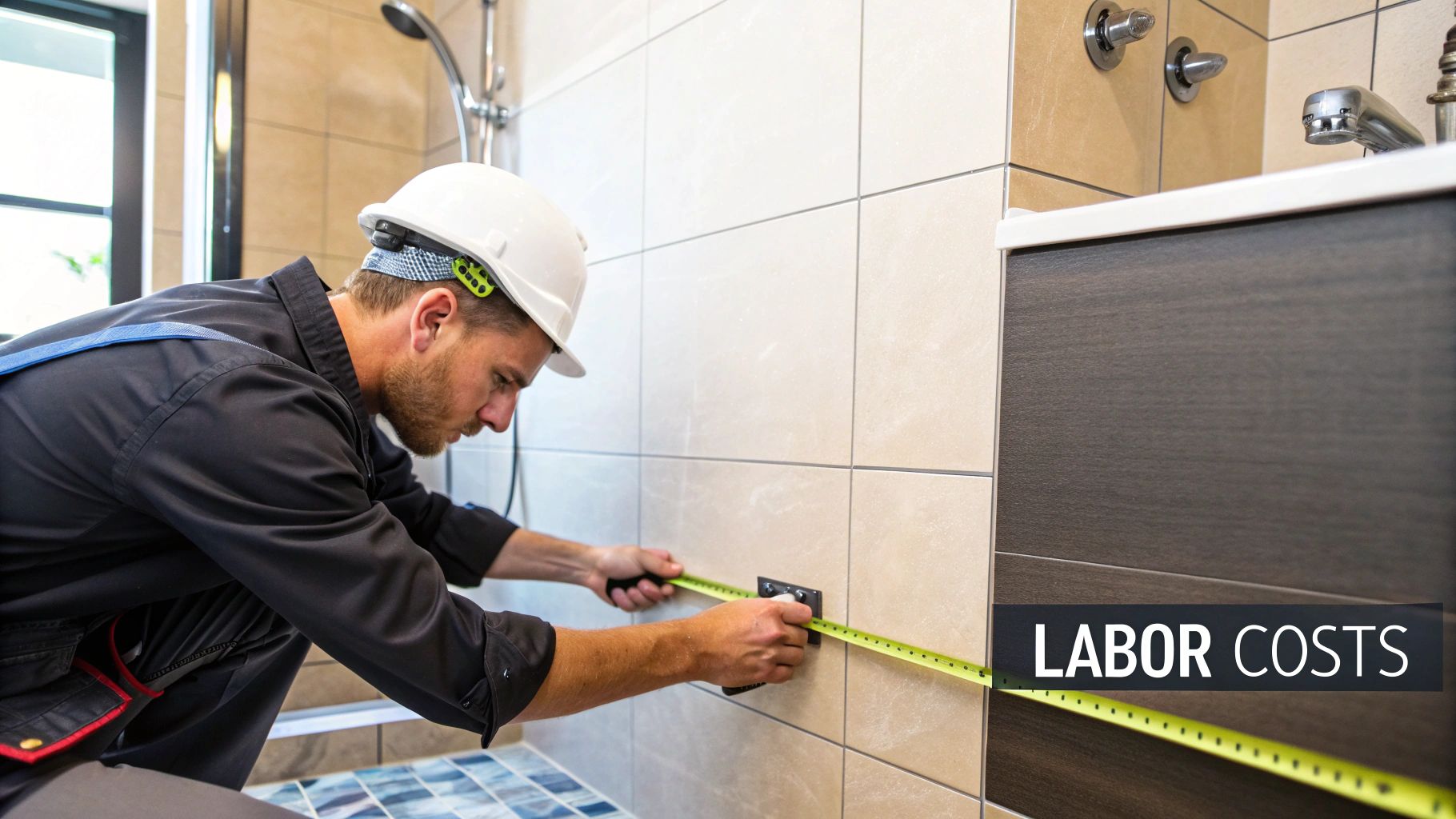
See for yourself how our innovative designs can transform your bathroom into a personal sanctuary.
Explore CRANACH Shower Systems Now


